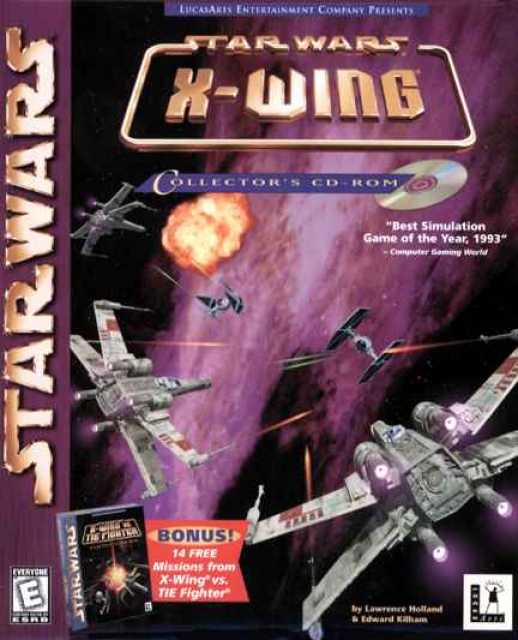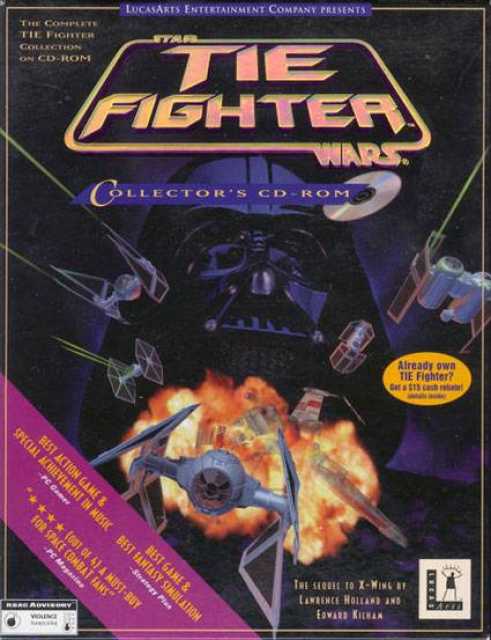Overview
Introduced to the world in February of 1993 with Star Wars: X-Wing, the Star Wars: X-Wing franchise is a series of space combat flight simulation games created by Totally Games (led by Larry Holland and Edward Kilham) and distributed by Lucasarts. As its name implies, the franchise is set within George Lucas' Star Wars universe, and all releases within it are set concurrent to the original trilogy, as they predate the cinematic release of the prequel trilogy (the last game, X-Wing Alliance, was released roughly three months prior to The Phantom Menace). There are four primary titles in the franchise, which are, in order of release, Star Wars: X-Wing, Star Wars: TIE Fighter, Star Wars: X-Wing vs. TIE Fighter, and Star Wars: X-Wing Alliance; all games in the series, with the exception of the last, received at least one official expansion as well. Though they differ in the particulars, games in the X-Wing franchise focus primarily on dogfighting between spacecraft of the Rebel Alliance and the Galactic Empire, and, apart from X-Wing vs. TIE Fighter, X-Wing titles are known for their lengthy single-player campaigns, which dovetail with the events of the original trilogy.
The Star Wars: X-Wing franchise directly ties itself not only to canonical Star Wars events, but also to the Stare Wars Expanded Universe with inclusions such as Grand Admiral Thrawn and the Z-95 Headhunter. Several new types of spacecraft were also created specifically for the series, such as the TIE Defender and the Missile Boat, some of which do not appear outside the X-wing games. The events depicted within the games are on the whole considered to be canonical happenings in the series' fiction, and over the course of its lifespan, X-Wing added a number of new characters to the Star Wars universe, with some of the more notable creations being Maarek Stele and Ace Azzameen, the protagonists of TIE Fighter and X-Wing Alliance, respectively, as well as Grand Admiral Zaarin, who organized an unsuccessful coup d'état against Emperor Palpatine.
Gameplay
Single-Player
The core gameplay of the X-Wing series revolves around simulated combat engagements between spacefaring vessels of the Empire and the Rebellion. During missions, the player controls a single starfighter from a first-person perspective, piloting it through a variety of hostile encounters, which can generally be divided into one of two categories: dogfights occurring between two or more ships of a similar size, or confrontations with larger and more dangerous capital class vessels. To prevail in combat, most ships are equipped both with short range beam weaponry, most commonly Laser Cannons or Ion Cannons, which can be recharged, as well as a limited supply of long range warheads such as Photon Torpedoes or Concussion Missiles, which must be used more judiciously. In addition to fighting off the enemy, the player is often tasked with accomplishing additional objectives in the midst of combat, such as defending a vulnerable allied target or acquiring important data, and furthermore missions may sometimes unfold in phases. Failure of any primary objectives will result in mission failure, as will the destruction of the player's ship.
Energy management is another crucial gameplay mechanic which must be properly accounted for in most missions. With the exception of some of the Empire's weaker ships, which are unshielded, all starfighters have individual subsystems for engines, shields, and lasers. The player is expected to designate how much power is allotted to each system as their mission demands, and with all systems drawing from the same power source, an importance is placed on finding the right balance between all three necessarily systems, as increasing power to one system directly decreases the amount available to the other two. Extremely advanced vessels may even have a fourth system devoted to an onboard Tractor Beam projector. In emergency situations, stored energy within a specific subsystem may be redirected to boost energy in another, allowing players, for example, to divert weapon energy in order to restore shielding at a faster than normal rate.
Rather than having a system of save states, the X-Wing games track progress in single-player by way of player profiles, which a new player must create before they are allowed to partake in missions. The profile system not only saves the player's progress, but also keeps track of a number of statistics regarding player performance. Additionally, over the course of the game players can amass various awards and commendations which can be viewed between missions. The intra-mission interface in the X-Wing games was designed to be immersive, as players are required to navigate a point-and-click two-dimensional representation of a starship rather than selecting options from a menu. This in-fiction presentation even at times includes transitional cutscenes to illustrate when a player is traveling from one area to another. It is through this interface that the player not only accesses the main story missions, but also engages in side activities such as training missions and historical simulations.
Multiplayer
Introduced in X-Wing vs. TIE Fighter, multiplayer operates on the same basic mechanical foundation as the franchise's single-player component while adding support for up to eight simultaneous players in a single scenario. The most basic multiplayer mode is Melee, which essentially consists of deathmatch-style dogfights between opposing starships. The second mode, Combat Engagement, is more similar to single-player missions, as matches contain overarching objectives for players to accomplish above and beyond simply destroying enemy fighters. Both Tournament and Battle modes exist as well, which are variants of Melee mode and Combat Engagements. In both cases, players participate in a series of matches rather than a single match, with the victor being determined by overall performance. Lastly, cooperative mission play is also possible, allowing groups of allied players to tackle objective-based missions together. The release of X-Wing Alliance added a race mode called Pilot Proving Grounds as well as a skirmish option that gives players the ability to create custom multiplayer missions.
Games
 X-Wing X-Wing | Set in the same general time frame as A New Hope, Star Wars: X-Wing's story mode portrays events prior to and in tandem with many of the events of the first movie, culminating in the iconic Death Star trench run above Yavin IV, in which the player assumes the role of Luke Skywalker. The three Tours of Duty in the original release were later supplemented by Imperial Pursuit and B-Wing, two supplemental tours that were available on floppy disk and prepackaged with later rereleases. Both expansion campaigns were significantly longer than those in the main game, and the last expansion also introduced the titular B-Wing, bringing the playable starship count to four. |
 TIE Fighter TIE Fighter | Shifting narrative focus from the Rebellion to the Empire, TIE Fighter follows the actions of Maarek Stele, one of the Empire's best pilots, as he rises up the Imperial ranks. TIE Fighter features a number of improvements over the previous game, such as the addition of Gouraud shading, though its gameplay is still very much in keeping with what was established in the previous title. Like X-Wing, TIE Fighter received two expansions, Defender of the Empire and Enemies of the Empire, augmenting the original game with six new Tours of Duty. The latter expansion was not released independently, though both were incorporated by default into later enhanced editions of the game. |
 X-Wing vs. TIE Fighter X-Wing vs. TIE Fighter | Representing a significant departure from previous games in the series, X-Wing vs. TIE Fighter (or XvT) shifts focus from single-player content, instead encouraging players to fight it out with up to seven other players online. XvT was a significant graphical improvement over the previous games, including hardware acceleration for the first time, though unfortunately it drew criticism from some fans due to the absence of any story-driven single-player campaign akin to those in previous games. Perhaps in response to these criticisms, XvT's one and only expansion, Balance of Power, included two narrative campaigns which portray a single series of events from both Rebel and Imperial perspectives. |
 X-Wing Alliance X-Wing Alliance | The last official release in the X-Wing franchise, X-Wing Alliance returns to the narrative focus of the series' earlier iterations, casting the player as Ace Azzameen, a neutral party in the galactic war who, through unfortunate circumstances, finds himself at odds with the Empire and increasingly sympathetic with the Rebel Alliance. From a gameplay perspective, X-Wing Alliance is primarily notable for allowing players to pilot several freighter-class ships. These larger vessels are differentiated from normal starfighters by heavier shielding and turret-mounted laser weaponry, though they are also far less maneuverable than other ships. |
Special Editions
Collector's CD-ROM (1994, 1995)
The Collector's CD-ROM editions of X-Wing and TIE Fighter brought various improvements to the core games. Graphically, the engine was upgraded to support 640x480 resolution, and in the case of X-Wing, certain options first introduced in TIE Fighter, such as Gouraud shading, were implemented. Much of the game's interface and cutscene artwork was also altered, and furthermore the audio presentation was significantly enhanced with new sounds and a large amount of additional voice over work for mission briefings. All previously released expansion content came included with the Collector's CD-ROM versions of X-Wing and TIE Fighter by default, and some missions that were judged overly difficult were given optional versions that are somewhat more forgiving.
Collector Series (1998)
Running on the X-Wing vs. TIE Fighter engine, the Collector Series compiled the first two X-Wing games into one package, while also offering a demo version of XvT called X-Wing vs. TIE Fighter Flight School. The most striking enhancement in the Collector Series is certainly the introduction of hardware-accelerated graphics to X-Wing and TIE Fighter, though it is also worth noting that the iMUSE-guided MIDI compositions used in the original releases were replaced in these versions by Red Book audio tracks of John Williams' Star Wars score. Once again, cutscenes and certain interface elements were redone in the Collector Series to take advantage of more modern capabilities.
X-Wing Trilogy (2000)
Star Wars: X-Wing Trilogy, the last compilation release of the X-Wing series, included X-Wing, TIE Fighter, X-Wing Alliance, and X-Wing vs. TIE Fighter Flight School. The versions of X-Wing and TIE Fighter included in this package are identical to the iterations that appeared in the earlier Collector Series, and X-Wing Alliance received no noticeable alterations in the transition to the X-Wing Trilogy. Though the games within receive no enhancements past what was previously available, X-Wing Trilogy is the most complete rerelease of the X-Wing games, as it is missing only the full version of XvT and its expansion, Balance of Power.
Log in to comment